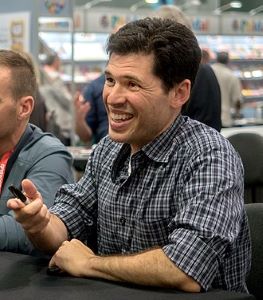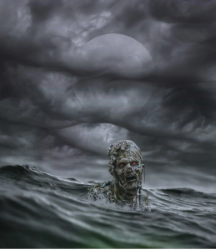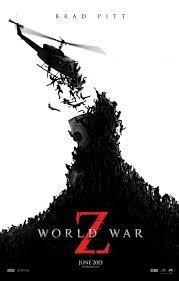
© Duckworth Books
Another Halloween-inspired post…
Zombie movies used to be my favourite sub-genre of horror cinema. Okay, at first, it’s difficult to see the charms of a school of movies about reanimated corpses shambling around and trying to munch on the living. But what I liked about zombies was that they could be a brilliant metaphor for any group that was large in number but, according to the powers-that-be, mindless: consumers, blue-collar workers, the homeless, etc. This gave filmmakers endless opportunities for social comment and allowed zombie movies to have brains figuratively as well as literally.
Thus, George Romero’s Night of the Living Dead (1968) is a parable about a United States rattled by racial tensions and the Vietnam War. His 1979 sequel Dawn of the Dead takes potshots at a consumerist America where shopping malls had become part of both the landscape and the social fabric. Danny Boyle’s 28 Days Later (2002) reflects a Britain where anger was an increasingly common social phenomenon, terms like ‘road rage’ and ‘air rage’ having entered the popular vernacular. Its sequel, Juan Carlos Fresnadillo’s 28 Weeks Later (2007) is an allegory about the post-war occupation of Iraq. And Edgar Wright’s Shaun of the Dead (2004) takes the piss out of a twenty-something slacker generation who can’t tell if someone’s a zombie or just stoned, drunk or hungover.
But I said I used to be fond of zombie movies, because in the last few years I feel there’s been too damned many of them, offering the same old apocalyptic visions and same old shambling tropes. Zombies have become ubiquitous, not just in the cinema but in TV series, books, graphic novels and computer games. With popular TV shows like The Walking Dead (2010-present), derived from a graphic novel, and The Last of Us (2023), derived from a computer game, filling our screens with zombie carnage week after week after week, surely it’s impossible now to do anything fresh with the concept?
Despite my zombie-fatigue, however, I recently read Max Brooks’ bestselling 2006 novel World War Z: An Oral History of the Zombie War. This is probably the number-two urtext in the zombie pantheon. (Obviously, the number-one urtext is George A. Romero’s original trilogy of Living Dead movies, Night, Dawn and 1986’s Day of the Dead, which created the template: the flesh-eating, the infection being spread by bites, the need to shoot them in the head, the humans reacting to the crisis soon becoming more monstrous than the zombies themselves.) Brooks updated the sub-genre for the 21st century and imagined a zombie plague happening on a global scale, with different countries responding in different ways.

From wikipedia.org / © Rhododendrites
World War Z is a mock non-fictional tome modelled on Studs Terkel’s The Good War: An Oral History of World War Two (1984). It’s purportedly a compilation of interviews by a United Nations expert who, sometime after a worldwide zombie crisis ended, worked on a UN Postwar Commission Report. He collected oral testimonies from survivors but, ultimately, the commission’s chairperson decided not to include the testimonies in the report, reasoning: “It was all too intimate… Too many opinions, too many feelings. That’s not what this report is about. We need clear facts and figures, unclouded by the human factor.” So instead, the UN expert publishes the survivors’ stories in book-form.
One’s first impression of World War Z is that Brooks – who in real life is the son of venerable funnyman and comic filmmaker Mel Brooks – has not only set his sights high but done his homework. The book believably presents the voices not just of ordinary people, but of politicians, scientists, doctors, soldiers, mercenaries, pilots, etc. It nicely captures their particular sets of jargon, slang and cadences as they describe their experiences of the conflict with the undead. The political protocols, science, technology, medicine, weaponry and equipment referred to sound convincingly well-researched. Brooks is also authoritative when his UN official interviews people from more specialist walks of life, such as deep-sea divers (these zombies can move underwater) and astronauts (there’s a section about the crew of the International Space Station who, after things kick off, find themselves in orbit for longer than planned and do all they can to help humanity below).
The jargon occasionally gets a bit dense. For instance, a diver grumps: “Kids today… f*ckin’ A. I sound like my pops, but it’s true, the kids today, the new ADS divers in the Mark 3s and 4s, they have this ZeVDek – Zero Visibility Detection Kit – with colour-imaging sonar and low-light optics… We couldn’t see, we couldn’t hear – we couldn’t even feel if a G was trying to grab us from behind.” But then, people in any profession use plenty of jargon when they talk with passion about their work. And you have to be passionate about your work when it involves relentless waves of zombies coming at you.

From pixabay.com / © Syaibatul Hamadi
A few entries stray into stereotypes and caricature, though. An account by one Kondo Tatsumi, a teenaged computer geek so addicted to hacking into systems and obtaining information that he stays at his bedroom computer long after his parents have vanished, and the zombies have started eating his neighbours, without any awareness of the peril he’s in, ladles on the stereotype of the Japanese otaku too thickly. To rub it in, Kondo is described as being at the time ‘a skinny acne-faced teenager with dull red eyes and bleached blond highlights streaking his unkempt hair.’
Another Japanese-set instalment is rather cheesy too. It concerns an elderly blind man called ‘Sensei’ Tomonaga Ijiro. Though old and blind, his sense of hearing and smell are acute and he’s also skilled at using a samurai sword – well, it’s really a sharp-bladed shovel that he used during his pre-World-War-Z days working as a gardener. He manages to survive for years in the forested mountains of Hokkaido, slaying any zombie that ventures near him. Here, Brooks is clearly riffing on the legendary blind swordman Zatoichi, a fixture of Japanese cinema and fiction. But the story’s unlikeliness is out-of-place in a tome that generally aims for documentary realism. Even if Sensei Tomonaga’s non-visual senses and swordsmanship enable him to fight off zombies for several years, I don’t see how an old blind bloke could stay alive in Hokkaido, in the open, for so long. I’ve lived in Hokkaido and know how brutal its winters are.
Worst of all is the testimony of David Allen Forbes, a stereotypical Richard Curtis / Hugh Grant-style silly-ass Englishman whom Brooks’ dad could have featured in one of his films – Robin Hood: Men in Tights (1993), say, or Dracula: Dead and Loving It (1995). An expert on castles, he begins by explaining how modern-day humans used the medieval structures as refuge against the zombie hordes. Then he gets onto his own experiences of World War Z, which he spent holed up in Windsor Castle, just outside London. There’s some utter guff where Forbes gets teary recalling Queen Elizabeth II. She refused to join the rest of the Royal Family when they were evacuated to Ireland – yes, it shows how desperate things were that the Royal Family, for their safety, had to be sent to Ireland. Instead, she stayed with the garrison in Windsor to ‘be an example to the rest of us, the strongest, and bravest, and absolute best of us.’ Of castles and Her Majesty, Forbes concludes: “One defended our bodies, the other, our souls.” That bit turned my stomach more than the most graphic gore I’ve seen in a zombie movie.
Still, the good parts of World War Z more than outweigh the duff ones. Most effective for me is a section where an American woman, Jesika Hendricks, recalls her experiences as a girl early in the crisis. Following government advice to move north – by then it’d been noticed that zombies freeze up in cold weather – her urban, white-collar family load up a van and head for Canada. They join some fellow refugees who’ve set up camp beside a lake. Initially, everything is cheery, with communal bonhomie, singing around the campfire, and the nearby forest and lake-waters providing fuel and food. Then, as the trees get cut down, and the fish get dynamited to non-existence, and the days grow shorter and colder, the mood sours. “The camp became a mess, nobody picking up their trash anymore. A couple of times I stepped in human shit. Nobody was even bothering to bury it.” By mid-winter, things have become truly nasty. It’s a grim and believable account of what frightened and unprepared people can end up doing in an emergency. And the zombies aren’t even around. They figure in the punchline, though: “It took a lot of time, but eventually the sun did come out, the weather began to warm, and the snow finally began to melt.. spring was finally here, and so were the living dead.”
Meanwhile, Brooks devises a neat explanation for the zombies’ origins and how they spread everywhere. The zombie-creating virus first appeared in China – possibly somehow spawned in the areas flooded by the Three Gorges dam project – and went on to infect the country’s supply of organs that’d been forcibly-harvested in its prisons. Some of these organs were exported around the world and they released the virus into the bodies of their recipients. Incidentally, in real life, China announced in 2014 that it would no longer use prisoners as forced organ-donors.

© Skydance Productions / Paramount Pictures
This premise didn’t make it into the big-budget, but disappointing movie version that Hollywood made of World War Z in 2013. No doubt the studio, Paramount Pictures, was mindful of the growing importance of Chinese audiences for international movie profits and didn’t want to include anything that might annoy the Chinese government.
Finally, I noticed how the book makes references, mostly indirectly, to personages like Nelson Mandela, Fidel Castro and the aforementioned Queen Elizabeth II. This gives it an oddly historical feel now. Its story evidently began in the mid-noughties and concluded sometime in the 2010s. And while Brooks pours scorn on inept and corrupt politicians, and other assholes in positions of power and influence (like a crooked pharma tycoon who lulls the West into a false sense of security with an ‘anti-rabies’ vaccination), he obviously believes the era still has enough people with the leadership skills, knowhow and courage to win the day for humanity.
But the mind boggles at the thought of such a scenario occurring in 2023. For years now, we’ve been subjected to the callousness, venality and stupidity of leaders like Putin, Bolsonaro, Modi, Netanyahu, Johnson and, of course, Trump. Also, we’ve seen how so many of them botched the handling of the Covid-19 epidemic. If a zombie apocalypse started under the watch of the far-right-wing populist authoritarians who currently run too many countries in the world, they’d probably use it as an excuse to invade neighbouring countries, burn the Amazon, bash the Muslims, avoid corruption charges, hold raucous parties, inject themselves with bleach or, indeed, abandon the ‘blue states’ to the zombies.
And on the fake-news front, millions of ‘zombie sceptics’ would agree with Alex Jones, who’d dismiss news footage of zombie carnage as the work of ‘crisis actors’. Millions of supposed ‘freethinkers’ would applaud the tweets of Right Said Fred and Neil Oliver, who’d dismiss the thing as a hoax engineered by a shadowy global cabal wanting to foist a ‘world government’ on us all. Actually, I could imagine Oliver defying zombie-emergency lockdown by announcing on GB News: “If your freedom means I might get bitten by a zombie then so be it. If my freedom means you might get bitten by a zombie, then so be it.”
Max Brooks’ 2006 World War Z chronicles a horror-show, but in hindsight, there’s ultimately something positive and uplifting about it. A 2023 World War Z would be a horror-show full-stop.

From invaluable.com / © Motik One
